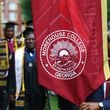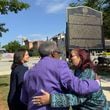Image 1: the Five Points MARTA station, where thousands of people exit and enter daily.
Image 2: wooden buildings, side by side like boxes on a shelf, with a sign "AUCTION & NEGRO SALES."
Both photos were taken from the same spot. A century-and-a-half separate them. It would take a war to dismantle one business and lay the groundwork for the other. On July 22, 1864, that war came to Atlanta when Union and Confederate forces clashed on the eastern edge of the city in the Battle of Atlanta.
“It is ironic this used to be a slave-auction hub” where people were bought, sold and dispatched to different places, said said Jeff Sopson, an African-American Air Force veteran exiting the station. “It is almost like a modern-day hub, being that African-Americans primarily use this hub to get to the places they need to go.”
Not one commuter interviewed on a recent morning knew the MARTA station is built on a site where people once stood in chains.
“I guess it is a shock, and not a surprise, is the best way to describe it,” said Tim Merritt, a white Georgia native who works at Georgia State University. “The part that is a shock is that such a familiar place has such a wretched past. But it is not a surprise, because Atlanta was part of the Confederacy.”
No signs commemorate the peculiar commerce that once took place on that spot. In other parts of the metro area, history has not been so discreetly elbowed aside.
Reminders of that war are all over the region — aged markers commemorating key moments in the battle for the city; the Cyclorama, where a massive painting details the fight that unfolded that hot afternoon; Stone Mountain, where a soaring granite monument is permanent reminder of the war in our backyards.
No event has had a greater impact on Atlanta, or embraced so many ironies. A war fought in part to preserve a plantation economy helped create the South’s largest city. Atlanta, where humans were bought and sold, has a black mayor, the latest in a line of African-American leaders. The war made way for another battle, also fought in Atlanta and elsewhere, for civil rights.
For some, the 1861-65 war looms as large today as it did when cannons thundered in East Atlanta. Stephen Davis is one.
Davis, 65, has written two Civil War books, including his latest: “What the Yankees Did to Us: Sherman’s Bombardment and Wrecking of Atlanta.”
“Not only do we (enthusiasts) think about it,” he said, “but we think about it every day.”
Others view the war differently, when they view it at all.
“Do we talk about the Civil War? No. It is almost as if the Civil War doesn’t exist,” said Akbar Imhotep, an African-American and a professional storyteller. “We say, ‘That battle was won. It is over, so why talk about it?’ They feel the same way about slavery, because it is in the past and is painful.”
‘The lost cause is very much alive’
Google “lost cause” and prepare to spend some time at the computer. Some scholars say the “cause” is history rewritten to lessen the role slavery played in the war, with an emphasis on other factors that led to hostilities. Among them: states’ rights and an aversion to an overbearing federal government. These topics still resonate in Internet chats, in political gatherings and on radio studios.
The "cause" never really went away, said Gordon Jones , military historian at the Atlanta History Center. He oversaw the recent opening of "Civil War Odyssey," the history center's latest exhibit, and has talked with people of all persuasions, all opinions, about that war.
“The ‘lost cause’,” he said, “is very much alive.”
Confederate Memorial Day remains a holiday for more than 160,000 state workers. In 2009, the Legislature passed a law declaring April Confederate Heritage and History Month.
Cumming, just 40 miles up the road from Atlanta, issued a proclamation of Confederate history month this year. It also provides space in a city-owned building for the Bell Research Center, named after a Cumming native and Confederate officer, Col. Hiram P. Bell, who became a congressman after the war.
The Sons of Confederate Veterans and the United Daughters of the Confederacy remain devoted to the memory of those long-ago soldiers.
Calhoun resident Margaret Anderson, whose Tennessee and Georgia ancestors wore gray, is president of the United Daughters of the Confederacy, Chapter No. 2526. She considers it a heritage group remembering southern combatants in the War Between the States.
“I don’t call it the Civil War,” Anderson said. “There was nothing ‘civil’ about it.”
What’s civil, she asked, about an army that invades from the North?
What’s civil, asked Michael Thurmond, about slavery? A former state labor commissioner, Thurmond is a Civil War buff and a black man. He doesn’t think the two are incompatible.
“The Civil War was a triumph for human rights,” said Thurmond, now superintendent of the DeKalb County School District. “How can you not celebrate that if you believe in human dignity?”
‘Why do we have to talk about that?’
A westerly breeze blew across Memorial Drive, where a state employee struggled to erect a Battle of Atlanta commemorative marker. The sign, the replacement for a marker that was wiped out by a car, is close to the YMCA Youth & Teen Development Center.
Henry Bryant watched and nodded. He's chairman of B*ATL, an annual observation of the Battle of Atlanta, a series of events commemorating the battle with tours, reenactors and one cannon that rattles windows from Candler Park to Reynoldstown.
Many people don’t embrace a history that features bloodshed and dismembered soldiers, he said. Bryant recently passed out flyers promoting B*ATL at a farmers market, to predictable reactions.
“Some families recoiled,” he said. “They said, ‘Why do we have to talk about that?’”
Reconstruction deepened a racial rift that already existed, said Rolundus Rice, a native Atlantan and former history professor at Tuskegee University. Like the war itself, Reconstruction is viewed through different lenses. Was it an indignity foisted on a conquered nation, or an attempt to help a renegade region back on its feet?
“Reconstruction was a failure, because they (whites) feared ‘Negro domination’,” Rice said. “Once that fear got set in the white culture, they had to make sure that black folks did not gain political and economic power.”
The federal government eventually abandoned Reconstruction, opening the way for those who’d held power before the war to return to positions of influence — creating, too, a postwar society nearly as unequal as the one that preceded it. Southerners’ hatred of Reconstruction helped spur the growth of the Ku Klux Klan; to this day, that organization’s terrorist legacy lingers.
Devastation ‘became a development tool’
Many cities suffered during the Civil War, but few experienced anything like the devastation of Atlanta, said William Link, a history professor at the University of Florida who has studied post-Civil War America. It was, in some regards, a tattered blessing.
Vicksburg, under siege for months, sustained relatively minor property damage when it fell; the same was true of Richmond, capital of the Confederacy. Residents of both cities restored their buildings — and, in some measure, said Link, their past. Atlanta, nearly leveled by artillery and fire, didn’t have that luxury, Link said.
Atlanta’s battered landscape “became a development tool,” he said.
Entrepreneurs — local people, certainly, but also freed slaves and former Yankee soldiers who decided that living in Georgia beat life in Ohio — got busy. White Atlantans rebuilt with mortar and stone, wood and shingle. A new city rose on the rubble of the old and looked to the future.
And black residents? “For them, it (the war) was about rebuilding their lives as free people.”
Atlanta cannot fully turn its back on the past, and that makes some people uncomfortable, said historian Michael Shaffer.
"I guess it shouldn't be surprising when people say, 'That's a part of history I don't want to think about,'" said Shaffer, a historian who recently left his position at Kennesaw State University's Civil War Center. "But you can't rewrite history."
He is helping chart earthworks along the Cobb County side of the Chattahoochee River, where troops dug in and fought 150 years ago. As part of the study, focus groups met to discuss the structures’ future. To his “pleasant surprise,” Shaffer said, African-American participants urged the trenches’ preservation.
But on one point, he said, they were emphatic: “They didn’t want the Confederate battle flag flown there.”
Sherman the devil, Sherman the hero
The past, said C.T. Vivian, a noted civil rights veteran and recipient of the presidential Medal of Freedom, still stings.
“In every town you went to, you saw a statue of a white southern soldier,” he said. “That created a negative environment.”
Wendy Venet, a history professor at Georgia State University, recalled a Civil War graduate course she taught this summer.
Two students — white, and from Georgia — revealed they’d been raised to think Union General William T. Sherman was “a devil,” said Venet, author of “A Changing Wind: Commerce & Conflict In Civil War Atlanta.”
Another student — black, and originally from Philadelphia — offered a different perspective.
“His family history,” she said, “had Sherman as a hero.”
At Five Points, Maurice Eugene Mitchell was on his way to an appointment that he hoped would lead to a major deal selling his custom-made bow-ties. The station was in its morning tumult: nearby, a MARTA cop told a kid on a skateboard to beat it; a vendor hawked Cokes; people jaywalked in every direction.
Mitchell paused for a moment to assimilate the two images: the slave market and the transit stop, people in chains and people on the go.
“It is always good to know a little about Atlanta’s history when it comes to black people,” said Mitchell, who is black. “But there is so much other stuff going on in the world that we need to move on.”





